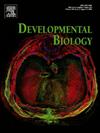Comparative analysis of neural crest development in the chick and mouse
IF 2.5
3区 生物学
Q2 DEVELOPMENTAL BIOLOGY
引用次数: 0
Abstract
A core framework of the gene regulatory network (GRN) governing neural crest (NC) cell development has been generated by integrating separate inputs from diverse model organisms rather than direct comparison. This has limited insights into the diversity of genes in the NC cell GRN and extent of conservation of newly identified transcriptional signatures in cell differentiation and invasion. Here, we address this by leveraging the strengths and accessibility of the avian embryo to precise developmental staging by egg incubation and use an integrated analysis of chick (HH13) and mouse (E9.5) embryo tissue samples collected during NC cell migration into pharyngeal arches 1–2 (PA1 and PA2). We successfully identify a cluster of NC cells containing both mouse and chick cells that share expression of Lmo4, Tfap2B, Sox10, and Twist1, and distinct genes that lack known conserved roles in NC. Importantly, we discovered a cluster of cells exhibiting a conserved transcriptional signature associated with the NC cell migratory wavefront in both mouse and chick, including KAZALD1, BAMBI, DES, and GPC3. We confirm their expression is restricted to leader mouse NCs by multiplexed FISH. Together, these data offer novel insights into the transcriptional programs that underlie NC cell migration and establish the foundation for future comparative functional analyses.

鸡与小鼠神经嵴发育的比较分析。
控制神经嵴(NC)细胞发育的基因调控网络(GRN)的核心框架是通过整合来自不同模式生物的单独输入而不是直接比较产生的。这限制了对NC细胞GRN中基因多样性的了解,以及在细胞分化和侵袭中新发现的转录特征的保护程度。在这里,我们利用禽胚的优势和可及性来解决这个问题,通过鸡蛋孵化来精确发育阶段,并对NC细胞迁移到咽弓1-2 (PA1和PA2)过程中收集的鸡(HH13)和小鼠(E9.5)胚胎组织样本进行了综合分析。我们成功地鉴定了一组NC细胞,其中包含小鼠和鸡细胞,它们共同表达Lmo4、Tfap2B、Sox10和Twist1,以及在NC中缺乏已知保守作用的不同基因。重要的是,我们在小鼠和雏鸡中发现了一组与NC细胞迁移波前相关的保守转录特征的细胞,包括KAZALD1、BAMBI、DES和GPC3。我们通过多路FISH证实它们的表达仅限于先导小鼠nc。总之,这些数据为NC细胞迁移的转录程序提供了新的见解,并为未来的比较功能分析奠定了基础。
本文章由计算机程序翻译,如有差异,请以英文原文为准。
求助全文
约1分钟内获得全文
求助全文
来源期刊

Developmental biology
生物-发育生物学
CiteScore
5.30
自引率
3.70%
发文量
182
审稿时长
1.5 months
期刊介绍:
Developmental Biology (DB) publishes original research on mechanisms of development, differentiation, and growth in animals and plants at the molecular, cellular, genetic and evolutionary levels. Areas of particular emphasis include transcriptional control mechanisms, embryonic patterning, cell-cell interactions, growth factors and signal transduction, and regulatory hierarchies in developing plants and animals.
 求助内容:
求助内容: 应助结果提醒方式:
应助结果提醒方式:


